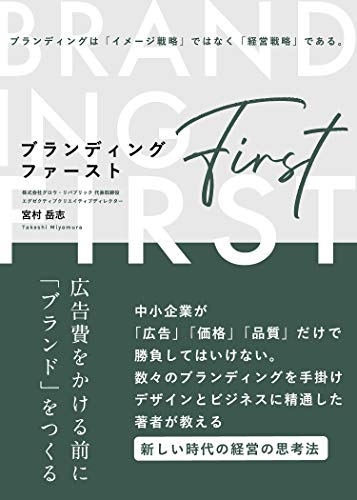When Should You Start Being Conscious of Branding?

It goes without saying that branding is crucial for companies.
Many companies, such as Apple, Disney, Starbucks, and Nike, have achieved great success due to their branding.
However, it's difficult to focus on branding right from the start. In the early stages of a startup, the nature of the business often changes frequently. So, when should a company start focusing on branding? Let's consider this based on Takeshi Miyamura's "Branding First."
What is Branding
The origin of the term 'brand' comes from livestock owners branding their cattle to distinguish them. This practice of marking livestock or wine barrels with a symbol to indicate origin or ownership is where the concept began.
For a company, branding refers to the strategies used to establish what they want or need to be known for as a universally recognized brand.
It seems that a product is not always necessary for branding. Even companies providing services, like consulting firms or law firms, can engage in branding.
The essence of branding is to clarify the 'ideal image' of the company. What do you want to become? How do you want to be perceived? What is your mission? What can you bring to society? When these are clear, the direction to move forward becomes clear as well, leading to unity of purpose among employees, reduced waste, and faster decision-making.
Why Do Branding
With the changes in times, there has been a shift from an 'economy of scale' to an 'economy of quality'.
Probably everyone has been to a dollar store. These stores are overflowing with products that make you wonder, "Is this really just a dollar? Isn't it too cheap?"
Convenience stores and supermarkets with their private brand (PB) products are a prominent example. Due to their large scale, they can significantly reduce costs compared to small and medium-sized enterprises and have overwhelming development capabilities. As a result, they continuously produce products that are not just 'cheap but mediocre,' but 'cheap yet high quality.'
This background is substantially rewriting users' perception of what constitutes an 'average product.'
In such times, for a startup to compete directly with the development power of large companies in a commoditized market (where products become homogeneous and lose added value) is a battle they cannot win.
It's a poor strategy for startups to compete on the basis of 'cheapness.'
How to Do Branding
For branding, it's important to focus on POD (Points of Difference).
POD is a standout strategy aimed at 'overtaking' competitors with similar evaluations by adding new elements to a product to gain higher appreciation. An example in the tea industry could be products certified as Specific Health Food (Tokuhon) or special items sold at tourist destinations, focusing on unique water or tea leaves.
This is similar to the common saying in the startup world, "To beat big companies, target niche areas." Having unique strengths is key to successful branding.
Our product, microCMS, falls into the relatively new category of headless CMS in Japan. While the number of companies offering hybrid CMS, which combines traditional CMS with API, is increasing, there are very few that provide a fully headless (API only) CMS, so we seem to be differentiating ourselves with POD.
However, there are many headless CMS options abroad, so we have not completely differentiated ourselves in that space. Considering the possibility of foreign products entering Japan or microCMS expanding overseas, adapting the UI/UX to unique Japanese business practices seems like it could be a strength.
Will Japan's unique business practices appeal overseas? I believe this could be our niche. For example, a phased review feature might resonate well in specific markets.
Branding might be more important in the consumer-oriented (C-facing) sector.
The previously mentioned companies - Apple, Disney, Starbucks, Nike - all primarily offer consumer-facing services/products.
Since branding is about instilling an image in consumers' minds, it likely has a direct impact in the consumer sector.
This seems particularly true for the increasingly popular DtoC (Direct to Consumer) services.
The Effects of Branding
What specific effects can branding have? The book explains that there are effects for both the outer and inner aspects of a company.
Effects on the Outer Aspect
- Assurance Effect (knowing the brand gives assurance in purchasing)
- Differentiation Effect (being chosen among similar products)
- Added Value Effect (being chosen despite a higher price compared to other products)
All of these are very powerful, especially the third, the added value effect, which I think is particularly beneficial for startups. As startups cannot beat large companies in marketing power, the secret to growth is to consistently sell at a higher price point.
(There are rare cases, like Clubhouse, where viral effects lead to explosive growth...)
Effects on the Inner Aspect
- Strengthening of Brand Power
- Attracting Excellent Talent
- Workstyle Reform
When a company's branding is established, employees feel proud to be part of it. This leads to higher enthusiasm for work and lower turnover rates. It also has a significant effect on recruitment.
The profits gained from good performance should be returned to employees through salaries and benefits, creating a positive spiral.
According to the book, the correct order is to permeate branding internally before reflecting it in the product.
What Specifically Should Be Done?
In the 'Information Collection Phase,' gather and organize information thoroughly for understanding and prediction. In the 'Development Phase,' clarify what should be the pillars of your brand and develop its strategic direction. In the 'Concretization Phase,' consider design and marketing to refine and concretize the pillars.
Thus, there are three phases:
- Information Collection Phase
- Development Phase
- Concretization Phase
First, gather from all employees what they think are the company's characteristics and strengths. In brainstorming sessions, focus on quantity over quality to generate many ideas.
Grouping these ideas helps identify common and unique elements.
Common elements among much information indicate something recognized by members from various positions in the company, leading to the pillars of the enterprise. Unique elements, although not common, may represent individual skills of members and can potentially be cultivated as strengths of the company.
Common elements form the foundation of the brand, while unique elements provide hints for developing a differentiated brand.
In the Development Phase, organize the information gathered in the Information Collection Phase to clarify and determine the direction of the brand development. Start by considering the following items:
- Target Persona: The customer segment targeted by the brand
- Functional Value: Concrete benefits offered by the brand
- Emotional Value: The ambiance and feelings associated with the brand or product
- Brand Personality: Character and personality if the brand were personified
- Brand Promise: The value proposition promised to customers by the brand
An example applied to Starbucks is as follows:
- Target Persona: Busy, urban people
- Functional Value: Delicious coffee served in a sophisticated space
- Emotional Value: A sense of comfort and relaxation; expressing a creative and free self
- Brand Personality: Urban yet friendly with a certain flair
- Brand Promise: Offering a rich and fulfilling third place for customers
It's good to think of Brand Personality in terms of a real celebrity. Would it be Naoto Takenaka, Teruyuki Kagawa, or Takuya Kimura? Imagine the perfect actor you'd want in a commercial representing your company.
In the final Concretization Phase, develop the Brand Identity (BI).
BI encompasses logos, colors, messages, etc., that convey the brand image. It's akin to the brand version of Corporate Identity (CI). Companies like P&G, with various brands like Pampers and Pringles, have separate BIs for each brand, while companies like Apple use one mark across all products.
BI involves developing visual identity (VI) such as logos and symbols that visually convey the brand image, and slogans that intuitively convey the brand message.
Ultimately, it's crucial that all of the company's touchpoints align with the brand concept in visuals and experience. The more cohesive they are, the greater the presence.
When Should You Start Focusing on Branding?
Considering all the above, the right time to focus on branding seems to be 'as early as possible.'
However, for startups, the product must achieve Product-Market Fit (PMF) first, as this is crucial for survival. It might be appropriate to start focusing on branding around the time the business outlook becomes somewhat clear, maybe around Series A funding. This is also when the number of employees often starts to increase rapidly.
Looking back, it seems common for companies to rebrand around their Series A funding. (It might also be the time when they finally onboard a designer...)
Thoughts
I wonder how microCMS is perceived by everyone.
Since it's a service that takes over the backend, making frontend developers happy, I personally hope to make it a service that frontend developers aspire to. In this sense, not only refining the product but also external communications (blogs, speaking engagements) seem important.
Continuing to prioritize 'User First' is also essential.
(It was one of Yahoo's values where I used to work. Looking back, values like 'Choose wild when in doubt' and 'Focus' were good...)
It might still be too early to start focusing on branding, but it's certainly necessary to verbalize and have a common understanding of our strengths and weaknesses internally. Also, our VI (Visual Identity) is quite vague, so I want to rethink that properly.














